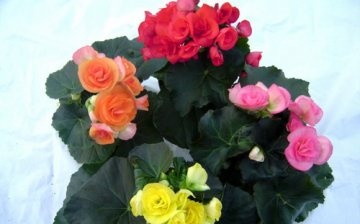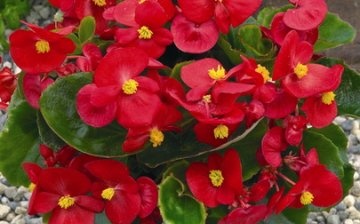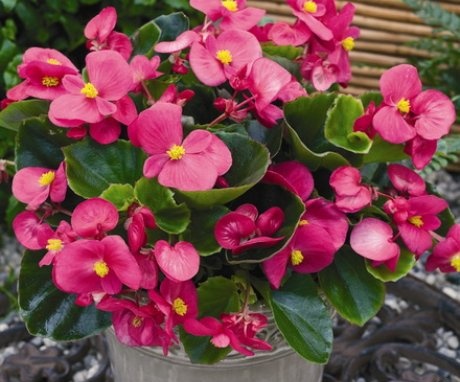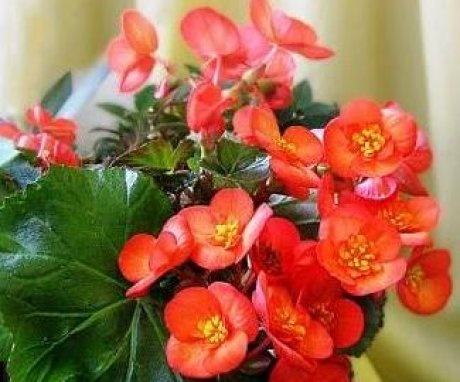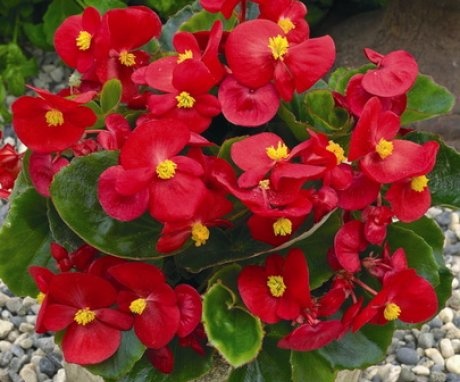Cultivation and reproduction of ever-flowering begonia
Ever-flowering begonia is a truly magnificent plant that adorns our balconies and flower beds almost all year round. Her flowers do not seem to like loneliness, so she always blooms profusely. In principle, begonia is an unpretentious plant, but it does not tolerate frost. Even from a slight frost, its leaves can die. It is important to know how to properly grow and propagate this flower.
Content:
Description of begonia
An ever-flowering perennial plant first appeared in Brazil in 1821. This flower does not take up much space; its simple rounded leaves can be of different colors. There are varieties of begonias with light green leaves, and there are also burgundy ones. Due to such a variety of colors, these plants make pretty flower beds and borders. This flower grows in height from 10 to 36 cm. Flowers are usually white, pink, coral and various shades of red.
There are about 2000 species of begonias in the world, each of which is beautiful in its own way. You can often find hybrid varieties such as Senator, Queen, Emperor. All types of begonias are divided into decorative potted and decorative deciduous. Some varieties are capable of growing only outdoors, others are adapted only for indoor cultivation. But there are also universal varieties that grow in the garden and in the apartment.
Despite the huge variety of begonias, the main characteristics and care behind him is the same. All of them have a fleshy stem, strong root system and asymmetrical leaves. They are unpretentious in care, but they do not like direct sunlight, strong waterlogging of the soil and frost.
To save begonia in winter, before the onset of frost, it is transplanted into pots and stored indoors, and in spring it is again planted in open ground.
Planting and leaving
Begonia is planted in a flower bed when frosts are no longer expected. For her, it is better to choose a well-lit area, since in dark areas the flower blooms poorly and develops poorly. Ever-flowering begonia does not like too wet soil. Therefore, when planting it, you need to take care of soil drainage.
Ideal if the soil for the flower is light, slightly acidic, rich in organic fertilizers... Due to the fact that this plant has an extensive root system, occupying about 20 cm of soil in depth, it is necessary to qualitatively prepare the site to this depth before planting.
The soil is well loosened, organic fertilizers are applied. Peat, rotted garden compost, or well-decomposed manure work well.
If the soil is heavy, it can be mixed with sand in the proportion of 2-3 kg per 1 meter of area. Caring for a garden begonia is no different from caring for other plants. This is abundant watering, regular loosening and fertilization of the soil.
In indoor conditions, the flower will grow well on windows with bright light. With a lack of light, it stretches. And with excessive sunlight, its leaves dry out, burns appear on them. In both cases, it is better to rearrange the plant to another place. Water the indoor begonia when the surface of the soil has dried 2-3 cm in depth.Watering should be plentiful, while making sure that excess water is completely drained.
Gardeners recommend fertilizing begonia in spring and summer with a weak solution of mineral fertilizer once every two weeks. In the middle of autumn and until next spring, it is not fed.
If necessary, this plant can be pruned. Trimming the tops stimulates the growth of lateral shoots. If you have been pruning the plant, it is important to reduce watering until vigorous growth resumes. In order to prevent the development of various diseases, it is necessary to regularly remove wilted leaves.
Reproduction of begonias
When breeding ever-flowering begonias, two methods can be used. This is propagation by seeds and cuttings. It is most convenient to propagate it by seeds. For this, it is necessary to provide good lighting and high-quality soil. Seeds are sown in boxes with soil in the middle of winter. They are not buried in the ground, they are simply scattered over the surface of the moistened soil. Sprinkle lightly with earth and cover with glass. The boxes with seeds are placed in a sunny place, moistened regularly, ventilated, and condensation is removed from the glass. As a result, the first shoots appear in 10-12 days.
It is not necessary to remove the glass immediately, it is necessary to gradually accustom the sprouts to environmental conditions. And after a month they can be transplanted into pots with fertile soil.
The second way to breed begonias is grafting... For this, overwintered plants are used, which have formed side shoots. To get such shoots, it is necessary to cut the selected bush short, water and feed it regularly, monitor the humidity of the air. Subject to these conditions, your begonia will reward you with a huge number of new shoots.
These new shoots are cuttings. They are cut and placed in cups of water or light soil for rooting.
Those who are fond of growing ever-flowering begonias know that these are not durable plants. After a few years, begonia loses its attractiveness. Therefore, it is important to be able to properly propagate this plant so that your site is always decorated with bright beautiful flowers.




